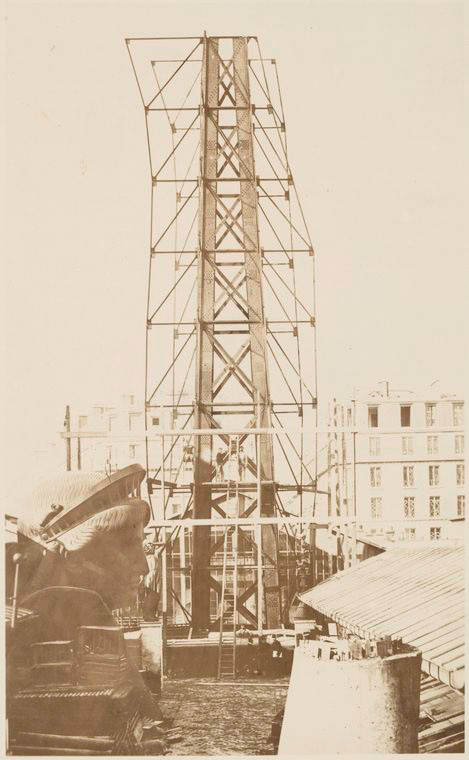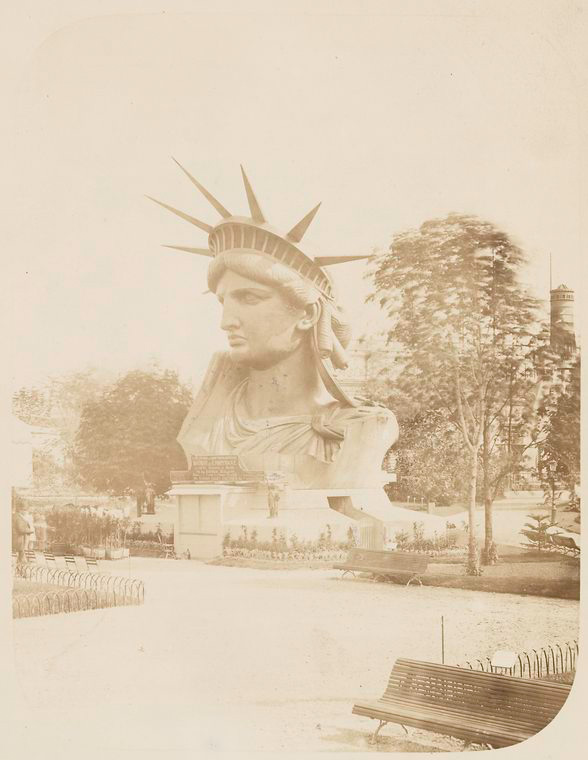There
is always a point in time when famous landmarks weren’t there. One
image of America which is fixed in the minds of millions is the Statue
of Liberty and the history of its construction is fascinating. Take a
trip back in time and see extraordinary behind the scenes images of the
creation of this superlative structure.

A
giant is formed. The sheer scale of the statue under construction can
be seen here, in contrast to the workmen posing woodenly for that fairly
new invention, the camera. The more formal name for the statue is
Liberty Enlightening the World and it is constructed with sheets of pure
copper, even though the picture makes it look something like marble. It
is something of a miracle that we now have the finished product
standing proudly on Liberty Island. Had it not been for the
contributions of ordinary French and Americans then she would never have
arisen in the first instance.

Such
is the immensity of the statue one can only wonder whether or not the
workmen pictured above had any idea which part of the statue they were
working on at any one time. The photographer Albert Fernique, who
captured these pictures around 1883, must have been in a certain awe at
the immensity of the statue and his images capture its sheer scale and
size beautifully. The French had decided to give the United States of
America something for their centennial independence celebrations that
the Americans and the world would never forget. The process of building
was painstaking, slow and fraught with financial difficulties. The
copper ‘shell' was only what the public would see. What lies beneath -
both in terms of its structure and the story behind its erection - is
almost as startling.

Officials
survey the workshop - models of statues can just be seen in the
background. While they probably had an idea that their statue would
become an icon of freedom the world over, the French politicians of the
day had some rather more down to earth reasons for gifting the immense
sculpture to the States. French politics. Perhaps for this reason the
source of the copper has never been revealed. The rumor had always been
that the copper was of Norwegian origin, from a village called Visnes,
rather than a French source. In 1985 Bell Labs confirmed that this was
fairly likely to be true.

At
the time France was in political turmoil and, although at the time
under their third republic, many people looked back at the time of
Napoleon and the monarchy before that with fondness and wanted its
return. The desire for a backwards step to authoritarianism was
worrying. French politicians - as wily then as now - saw Lady Liberty as
a way, albeit phenomenally huge, to focus the public's imagination on
republicanism as the best way forward. The USA and its centennial of
independence from the yolk of England was the perfect focus.

The
plaster surface of the left arm and its hand take shape, the skeleton
underneath revealed. As there is a deal of work under the carapace, so
the French politicians had ulterior motives. Using the USA - which many
saw as the ideal of government and populist aspirational politics - the
French used the statue as a Trojan Horse in reverse, as it were. Its
true purpose, in the eyes of the political gift givers, was to make
republicanism the center of political ideology in the minds of the
people. How greatly it succeeded can never fully be quantified but the
French cannot be faulted for thinking big. It must be said here that the
ordinary French, through their substantial buying of lottery tickets
(and other fund raising efforts) had a much purer purpose at heart than
their politicians.

It
must surely have been amazing for the workers to turn up each morning
to the sight of a colossal head looking down upon them. The inspiration
for the face seems to be the Roman god of the sun, Apollo or his Greek
equivalent, Helios. More down to earth sources of inspiration center on
the women in the life of the sculptor, Frederic Auguste Bartholdi. It
may well have been Isabella Eugenie Boyer, a good looking and well-known
figure in Paris at the time. More worrying, some believe the face of
the statue actually belongs to Bartholdi's mother. Bartholdi never
revealed the true model of the face, but if this is the case Freud would
have had a field day.

Bertholdi
made a small scale model first, which is still displayed in the Jardin
du Luxembourg in the city of the statue's original construction, Paris.
Before the statue was shipped to America, though, it had to be seen to
be tested. If it had not been for money, it may never have landed in the
states - particularly in the form we all know. On a visit to Egypt,
Bartholdi's vision of liberty expanded to its present proportions. Had
his original idea received financial support, then whatever gift the
French gave the Americans for the 1876 centennial could not possibly
have been the statue.

Little
by little, the statue arises. Bertholdi saw the Suez Canal under
construction in the eighteen sixties and was inspired to build a giant
figure at its entrance. He drew up plans which bore a remarkable
similarity to what now stands on Liberty Island but his ideas were
rejected by the Egyptian ruling body of the time because of the
financial problems the country was facing at the time. Had the statute
been built in Egypt as a lighthouse, the idea would never have been
taken up for America. The Statue of Liberty as we know it was in fact
used as a lighthouse, from its unveiling in 1886 right until 1902 - the
very first in the world to use electricity.

Almost
there! There were huge structural issues that had to be addressed in
the design and construction of a sculpture of such enormity. Enter a
certain Gustave Eiffel, who would later go on to build that eponymous
tower which still dominates the skyline of Paris. It was his job (which
he delegated to Maurice Koechlin, his favored structural engineer) to
ensure that Liberty's copper sheath could move while still remaining
vertical. Koechlin created a huge pylon of wrought iron and the famous
skeletal frame to ensure that the statue would not fall down in high
winds.

Money
was always a problem. The plan had been to get the statue to the US by
the fourth of July, 1876. Only the right arm and torch were finished by
then. However, as the Americans had taken responsibility for the
construction of the pedestal, these pieces of the statue were displayed
to the American public at the Centennial Exposition (in Philadelphia).
Money raised by allowing people to climb this part of the statue started
the funding efforts for the base of the statue. The French did their
bit too, showing the head in their own exposition in 1878.
1886
must have been one of those years that people remembered for the rest
of their lives. A statue of gigantic proportions, symbolizing the ideas
and aspirations of America, was unveiled by President Grover Cleveland
at Liberty Island (renamed from Bedloe's Island or Love Island). In an
ironic twist, President Cleveland had vetoed the New York legislature
from contributing fifty thousand dollars to help with the building of
the statue's pedestal. Letting bygones be bygones, President Cleveland
was more than happy to officiate at the ceremony. This had not been the
only problem to face the statue in the years before its final unveiling,
of course. From the model stage, above, to its triumphant moment of
revelation, the process was fraught with difficulty - mostly of a
financial nature. However, thanks to the efforts of both the American
and French people we now have a permanent reminder of what we should
hold dear - liberty still symbolically steps forth from her shackles to
protect, shelter and enlighten.










Source ..Google Search..

No comments:
Post a Comment